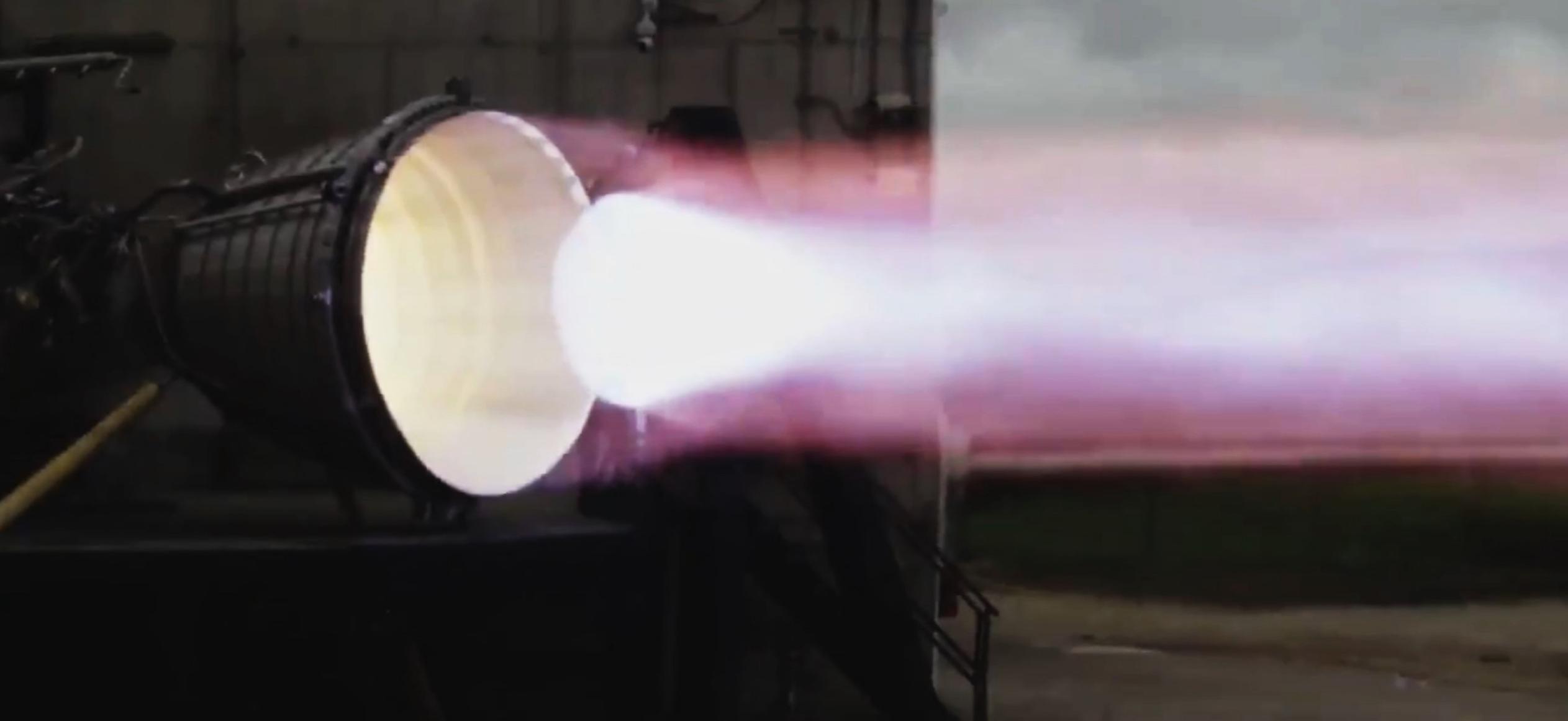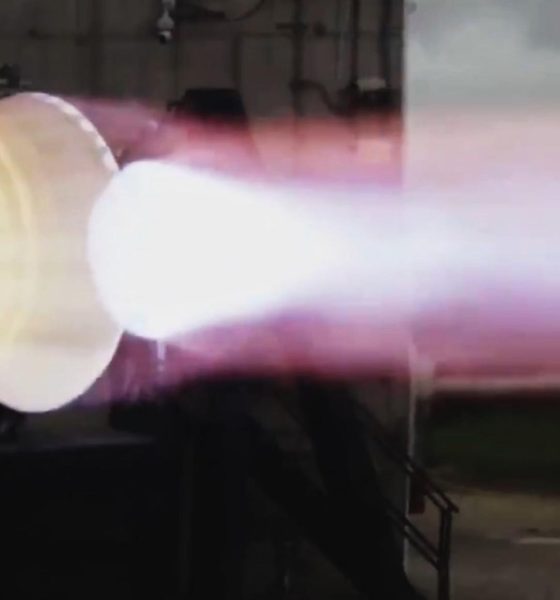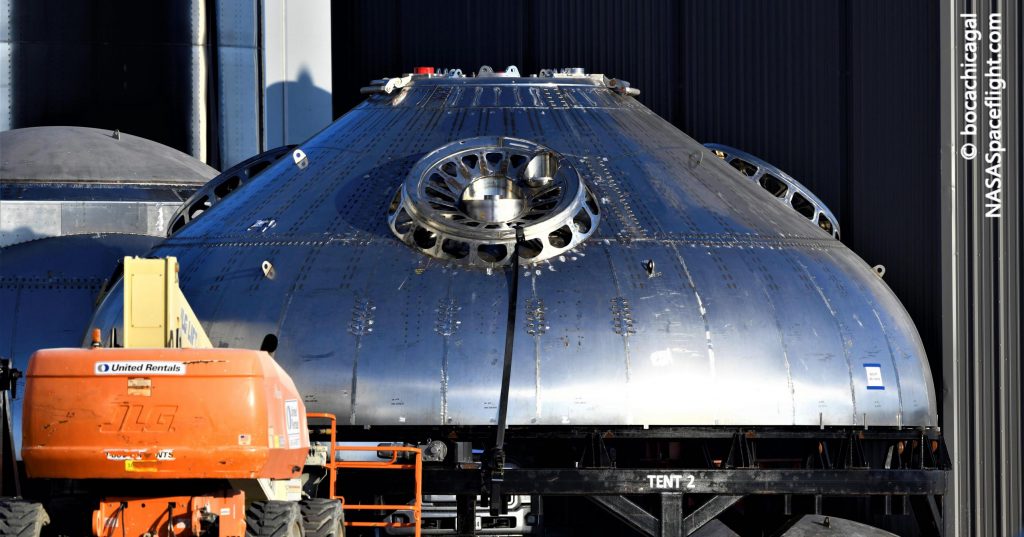

News
SpaceX sends Starship’s first vacuum Raptor engine to Boca Chica
For the first time, SpaceX has shipped a vacuum-optimized Raptor engine to its Boca Chica, Texas Starship factory days after the company’s present reiterated plans for an inaugural orbital launch attempt as early as July.
Back in March 2021, CEO Elon Musk confirmed that he’d set SpaceX a goal of attempting Starship’s first orbital launch no later than the end of July – around four and a half months distant at the time. Fifteen weeks later, though the prospects of an orbital launch attempt happening in July have practically shrunk to zero, SpaceX COO and President Gwynne Shotwell – best known for acting as a more grounded foil to Musk’s often impractical schedule estimates – reiterated that the company is still “shooting for July” for Starship’s first orbital launch attempt.
As of late June, hitting that target would require SpaceX to string together numerous extraordinary feats of engineering and rocketry in record time or attempt some extremely unorthodox corner-cutting.
The launch pad and launch vehicle hardware needed for Starship’s first space shot are currently far from ready for flight. On June 24th, Musk unexpectedly revealed that the Super Heavy booster prototype SpaceX is now in the late stages of assembly isn’t actually the booster that will carry Starship on its first space launch attempt. In other words, though dozens of rings in various states of work are strewn about SpaceX’s Boca Chica factory, the company has yet to begin assembling the massive 65m (~215 ft) tall booster required for the first orbital launch attempt.
Using Super Heavy Booster 3 (B3) as a ruler, assembly could easily take 9-10 weeks – starting whenever the process actually begins. If SpaceX started stacking Booster 4 today, in other words, it’s unlikely that the rocket would even be complete by the end of August. Barring SpaceX taking unprecedented shortcuts, completing the booster is just part of the process of preparing for flight and B4 would still need to be qualified for flight, likely involving at least one cryogenic proof and static fire test.
In a best-case scenario where SpaceX begins assembly today, manages to halve Booster 4 assembly time in one fell swoop, the sneaks the second Super Heavy ever completed through qualification testing in a single week, the orbital flight test booster still wouldn’t be ready for Starship installation (likely another unprecedented first) before mid-August.
That would then leave SpaceX five or six weeks to fully assemble Starship S20, a process that has yet to begin. Like Starship SN15, which Musk said sported “hundreds of improvements”, Musk has also stated that Ship 20 and all after it will feature another batch of upgrades needed to take Starship orbital. Starship SN15 was very gradually stacked and assembled over the course of almost four months, though that slow assembly can likely be blamed on the fact that SpaceX is busy testing Starships SN8 through SN11 and was effectively waiting to see if any other major changes might be required.

While most of S20’s upgrades are a mystery, the ship’s thrust dome – spotted in work at Boca Chica earlier this month – has already confirmed that the prototype will be the first with the necessary hardware for Raptor Vacuum engine installation. That likely means that S20 will also be the first Starship to attempt to static fire six Raptor engines*, potentially producing more thrust than a Falcon 9 booster. On June 27th, one such vacuum-optimized Raptor (RVac) arrived in Boca Chica for the first time ever, making it clear that the comparatively brand new engine may already be ready to start integrated Starship testing.
*Update: SpaceX CEO Elon Musk says that the Raptor Vacuum delivered to Boca Chica on June 27th is, in fact, meant for Starship S20, seemingly confirming that the prototype will fly with a full six Raptor engines.
Of course, beyond Starship and Super Heavy, SpaceX also has a great deal of work left to get the rocket’s first orbital-class launch facilities partially operational. SpaceX will need to complete and activate at least one or two more custom-built propellant storage tanks, sleeve those three or four tanks with three or four massive thermos-like ‘shells,’ complete thousands of feet of insulated plumbing and wiring, finish a massive ‘launch table,’ install that table on a six-legged ‘launch mount;’ outfit that table and mount with an array of power, avionics, hydraulics, and fueling equipment and plumbing; complete a ~145m (~475 ft) ‘integration tower,’ and perform the first fit checks and shakedown tests with a real booster or Starship.
Only then will SpaceX be able to attempt Starship’s first space launch. All told, it might not be literally impossible for SpaceX to complete all the above work in less than five weeks, but it’s safe to say that the odds of that happening could probably make a lottery ticket blush. Regardless, if Starship reaches orbit at any point before the end of 2021, it would beat out simpler “next-generation” rockets like Ariane 6, ULA’s Vulcan, and Blue Origin’s New Glenn despite beginning concerted development years later and with a far less certain funding situation.

Cybertruck
Tesla updates Cybertruck owners about key Powershare feature

Tesla is updating Cybertruck owners on its timeline of a massive feature that has yet to ship: Powershare with Powerwall.
Powershare is a bidirectional charging feature exclusive to Cybertruck, which allows the vehicle’s battery to act as a portable power source for homes, appliances, tools, other EVs, and more. It was announced in late 2023 as part of Tesla’s push into vehicle-to-everything energy sharing, and acting as a giant portable charger is the main advantage, as it can provide backup power during outages.
Cybertruck’s Powershare system supports both vehicle-to-load (V2L) and vehicle-to-home (V2H), making it flexible and well-rounded for a variety of applications.
However, even though the feature was promised with Cybertruck, it has yet to be shipped to vehicles. Tesla communicated with owners through email recently regarding Powershare with Powerwall, which essentially has the pickup act as an extended battery.
Powerwall discharge would be prioritized before tapping into the truck’s larger pack.
However, Tesla is still working on getting the feature out to owners, an email said:
“We’re writing to let you know that the Powershare with Powerwall feature is still in development and is now scheduled for release in mid-2026.
This new release date gives us additional time to design and test this feature, ensuring its ability to communicate and optimize energy sharing between your vehicle and many configurations and generations of Powerwall. We are also using this time to develop additional Powershare features that will help us continue to accelerate the world’s transition to sustainable energy.”
Owners have expressed some real disappointment in Tesla’s continuous delays in releasing the feature, as it was expected to be released by late 2024, but now has been pushed back several times to mid-2026, according to the email.
Foundation Series Cybertruck buyers paid extra, expecting the feature to be rolled out with their vehicle upon pickup.
Cybertruck’s Lead Engineer, Wes Morrill, even commented on the holdup:
As a Cybertruck owner who also has Powerwall, I empathize with the disappointed comments.
To their credit, the team has delivered powershare functionality to Cybertruck customers who otherwise have no backup with development of the powershare gateway. As well as those with solar…
— Wes (@wmorrill3) December 12, 2025
He said that “it turned out to be much harder than anticipated to make powershare work seamlessly with existing Powerwalls through existing wall connectors. Two grid-forming devices need to negotiate who will form and who will follow, depending on the state of charge of each, and they need to do this without a network and through multiple generations of hardware, and test and validate this process through rigorous certifications to ensure grid safety.”
It’s nice to see the transparency, but it is justified for some Cybertruck owners to feel like they’ve been bait-and-switched.
News
Tesla’s northernmost Supercharger in North America opens

Tesla has opened its northernmost Supercharger in Fairbanks, Alaska, with eight V4 stalls located in one of the most frigid cities in the U.S.
Located just 196 miles from the Arctic Circle, Fairbanks’s average temperature for the week was around -12 degrees Fahrenheit. However, there are plenty of Tesla owners in Alaska who have been waiting for more charging options out in public.
There are only 36 total Supercharger stalls in Alaska, despite being the largest state in the U.S.
Eight Superchargers were added to Fairbanks, which will eventually be a 48-stall station. Tesla announced its activation today:
North America’s northernmost Supercharger Fairbanks, AK (8 stalls) opened to public. https://t.co/M4l04DZ6B5 pic.twitter.com/zyL6bDuA93
— Tesla Charging (@TeslaCharging) December 12, 2025
The base price per kWh is $0.43 at the Fairbanks Supercharger. Thanks to its V4 capabilities, it can charge at speeds up to 325 kW.
Despite being the northernmost Supercharger in North America, it is not even in the Top 5 northernmost Superchargers globally, because Alaska is south of Norway. The northernmost Supercharger is in Honningsvåg, Norway. All of the Top 5 are in the Scandanavian country.
Tesla’s Supercharger expansion in 2025 has been impressive, and although it experienced some early-quarter slowdowns due to V3-to-V4 hardware transitions, it has been the company’s strongest year for deployments.
🚨🚨 Tesla Supercharging had a HUGE year, and they deserve to be recognized.
🍔 Opened Tesla Diner, a drive-in movie theater with awesome, Chef-curated cuisine
🔌 Gave access to Superchargers to several EV makers, including Hyundai, Genesis, Mercedes-Benz, Kia, Lucid, Toyota,… pic.twitter.com/yYT2QEbqoW
— TESLARATI (@Teslarati) December 10, 2025
Through the three quarters of 2025, the company has added 7,753 stations and 73,817 stalls across the world, a 16 percent increase in stations and an 18 percent increase in stalls compared to last year.
Tesla is on track to add over 12,000 stalls for the full year, achieving an average of one new stall every hour, an impressive statistic.
Recently, the company wrapped up construction at its Supercharger Oasis in Lost Hills, California, a 168-stall Supercharger that Tesla Solar Panels completely power. It is the largest Supercharger in the world.
News
Tesla shocks with latest Robotaxi testing move
Why Tesla has chosen to use a couple of Model S units must have a reason; the company is calculated in its engineering and data collection efforts, so this is definitely more than “we just felt like giving our drivers a change of scenery.”

Tesla Model S vehicles were spotted performing validation testing with LiDAR rigs in California today, a pretty big switch-up compared to what we are used to seeing on the roads.
Tesla utilizes the Model Y crossover for its Robotaxi fleet. It is adequately sized, the most popular vehicle in its lineup, and is suitable for a wide variety of applications. It provides enough luxury for a single rider, but enough room for several passengers, if needed.
However, the testing has seemingly expanded to one of Tesla’s premium flagship offerings, as the Model S was spotted with the validation equipment that is seen entirely with Model Y vehicles. We have written several articles on Robotaxi testing mules being spotted across the United States, but this is a first:
🚨 Tesla is using Model S vehicles fitted with LiDAR rigs to validate FSD and Robotaxi, differing from the Model Ys that it uses typically
Those Model Y vehicles have been on the East Coast for some time. These Model S cars were spotted in California https://t.co/CN9Bw5Wma8 pic.twitter.com/UE55hx5mdd
— TESLARATI (@Teslarati) December 11, 2025
Why Tesla has chosen to use a couple of Model S units must have a reason; the company is calculated in its engineering and data collection efforts, so this is definitely more than “we just felt like giving our drivers a change of scenery.”
It seems to hint that Tesla could add a premium, more luxury offering to its Robotaxi platform eventually. Think about it: Uber has Uber Black, Lyft has Lyft Black. These vehicles and services are associated with a more premium cost as they combine luxury models with more catered transportation options.
Tesla could be testing the waters here, and it could be thinking of adding the Model S to its fleet of ride-hailing vehicles.
Reluctant to remove the Model S from its production plans completely despite its low volume contributions to the overall mission of transitioning the world to sustainable energy, the flagship sedan has always meant something. CEO Elon Musk referred to it, along with its sibling Model X, as continuing on production lines due to “sentimental reasons.”
However, its purpose might have been expanded to justify keeping it around, and why not? It is a cozy, premium offering, and it would be great for those who want a little more luxury and are willing to pay a few extra dollars.
Of course, none of this is even close to confirmed. However, it is reasonable to speculate that the Model S could be a potential addition to the Robotaxi fleet. It’s capable of all the same things the Model Y is, but with more luxuriousness, and it could be the perfect addition to the futuristic fleet.








